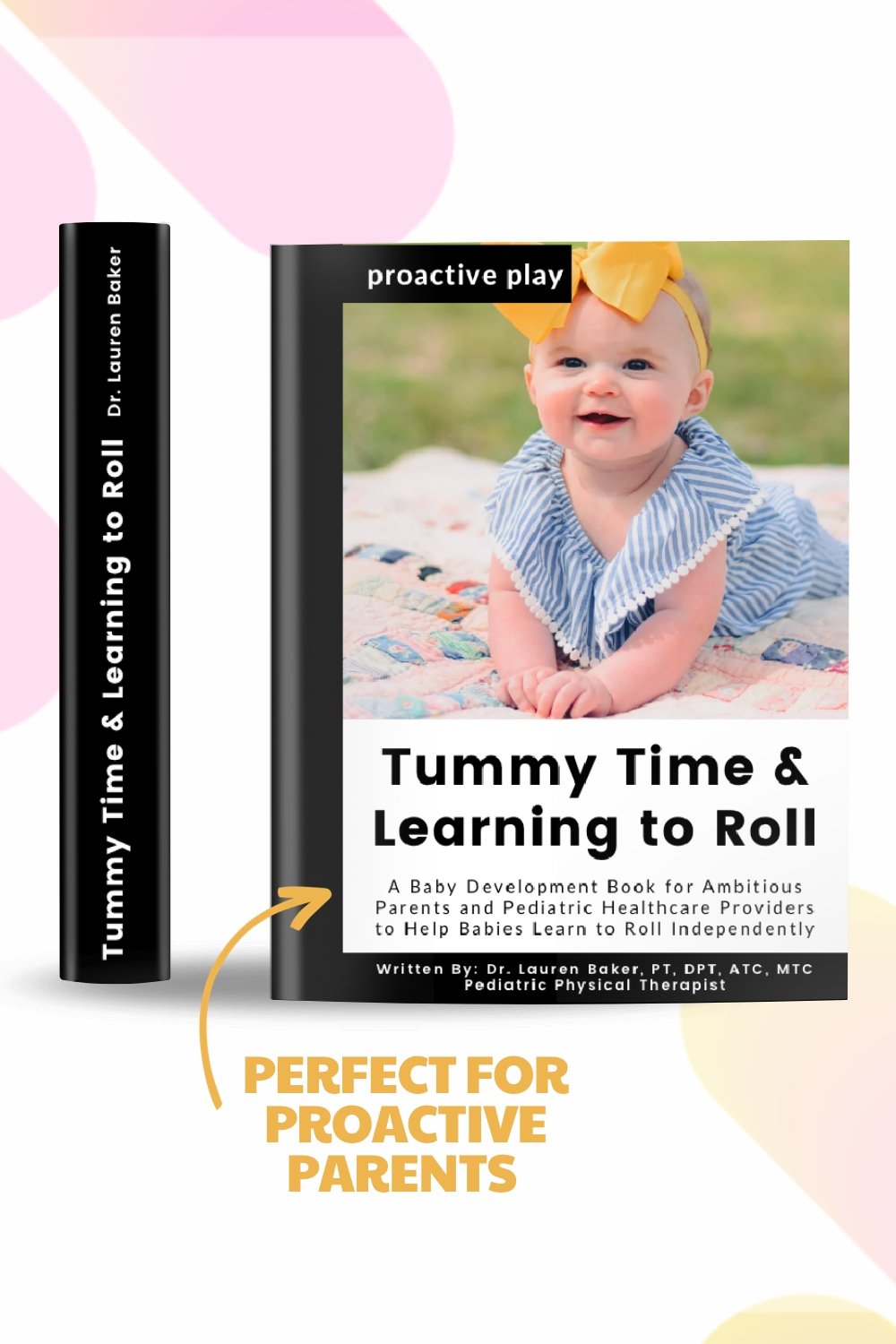Physical Therapy Exercises For 3 Month Old: Posterior Pelvic Tilt
this blog contains affiliate links
Hello, Proactive Parents! I'm Dr. Lauren Baker, think of me as your pediatric physical therapy bestie, to help you learn tips and tricks to help your littles move with confidence and ease.
Today, I'm excited to share a simple yet powerful strategy to support your baby's early development, particularly focusing on those little ones from birth to about four months old, the exercise/activity is called a “posterior pelvic tilt,” but mainly looks like you propping your little’s bum on your foot or another style of prop.
It sound really simple and it is, but it can have such a large gain and especially helpful for newborns and babies who may struggle with tummy time. You can do this physical therapy exercise on newborns 0-3 months olds, and even some 4 month olds. This exercise is great for general mobility, posture, and preparing for rolling.
Understanding the Importance of Posterior Pelvic Tilt
Let's dive into why helping your baby engage their lower abdominal muscles and work on rounding their back is so crucial. This technique is especially beneficial if you've noticed that your baby tends to arch their back a lot. The posterior pelvic tilt is the direction in which the pelvis or bottom is moving in, when a pelvis tilts “posteriorly,” it rounds the back and flexes the spine.
You can think of this like holding a bowl of water, if you tilt the bowl away from your body, the water flows away from you. If you tilt the bowl toward your body, the water flows toward you. If you tilt your pelvis forward/away from you, your back arches – if you tilt your pelvis backwards/toward you, your back flexes.
Babies need their pelvis to tilt both by themselves as well as by others. Babies who struggle with tolerating a pelvic tilt, specifically a posterior pelvic tilt may be at risk for struggling with milestones such as grabbing their feet, sitting independently, or crawling — all of which require a posterior pelvic tilt.
Why Focus on Babies Zero to Four Months Old?
In this newborn to early infant stage, babies are developing rapidly. Teaching them to flex their spine and tilt their pelvis up is essential. This supports them in tolerating other positions better, including tummy time, because they are engaging their core muscles in a posterior pelvic tilt and that allows for them to have a stronger trunk from which to lift their head, when they switch onto their bellies. It also prepares them for mini milestones like grabbing their feet, which comes around five months old.
The Challenge of Extension Posture in Babies
Some babies, particularly those who have had issues like reflux or certain in-utero positions, may favor extending their backs. This habit can be disadvantageous for their overall physical development. So, if you notice your baby resisting this natural pelvic tilt, it's beneficial to introduce some intentional, beneficial activities or reach out to a Pediatric Physical Therapist if they are struggling. See our list of in home pediatric physical therapists here.
Simple Strategy for Encouraging Posterior Pelvic Tilt
This is an easy activity that requires minimal effort from parents but offers significant benefits for your baby. You can use your foot, leg, a folded-up bath towel, or a pillow to prop up your baby's bottom. This position helps them relax into a gentle posterior pelvic tilt, aiding in belly relaxation.
Important Safety Note:
Always supervise your baby when using any external prop like a towel or pillow. Never leave them unattended in this position.
This position involves the baby lying on their back and then helping them round their back, by placing their pelvis on your foot or another prop. Holding this sustained flexed posture can help them relax into this position as well as increase core strength through isometric (one static position) strengthening, which tends to be an easy way for newborns to four month old babies to strengthen their muscles.
Make sure to watch the video below to see exactly how it is done safely with a baby:
TIMESTAMPS:
1:13 age of baby in video and why this position / exercise is important for 3 month olds and newborns.
3:29 posterior pelvic tilt physical therapy exercises for 3 month old
TOY IDEAS:
Toys for Babies Newborn-Rolling
Integrating Play and Development
While your baby is in this propped position, you can introduce various activities. From batting at toys to a gentle abdominal massage, these interactions not only enhance their physical development but also foster a deeper connection between you and your little one. See the toy idea links listed above for examples of good ideas of toys that can be utilized in this position. Any vertical hanging toys, like from a baby gym, or small, light toys that babies can safely hold in their hands such a teether toys or crinkle toys.
Duration for Maximum Benefit
Aim to keep your baby in this position for one to five minutes, depending on their comfort and tolerance. This duration is sufficient for them to relax into the posture and reap the benefits. If a baby is enjoying this position they can continue to stay in it for longer as long as they are supervised directly. Babies who struggle in this position may need to only stay in it for 10-15 seconds at a time, but be introduced to it more frequently in short bursts throughout the day until they can tolerate a full minute.
Personalized Tips and Tricks
As a pediatric physical therapist, I've worked with many babies and understand that each little one is unique. If you're seeking more tailored advice or have specific questions, I'm here to help through online parent consultations or by leaving comments directly below the youtube video.
Preparing for Future Milestones
Remember, these early exercises are foundational for upcoming milestones like rolling and improved tummy time tolerance. By incorporating these simple strategies into your daily routine, you're setting the stage for your baby's continued growth and development.
Curious About Learning More on Tummy Time, Rolling, or Both?
The absolute best book for parents on tummy time and rolling is: Tummy Time and Learning to Roll: A Baby Development Book for Ambitious Parents and Pediatric Healthcare Providers to Help Babies Learn to Roll Independently. The book comes with a free online video course to help parents fully understand how to complete the different exercises, printable checklists to know exactly where your baby is at, and when to reach out for additional help.
This book was written by Dr. Lauren Baker, PT, DPT, ATC, MTC, who is a Pediatric Physical Therapist in Boise, Idaho, trained in helping parents learn how to help their babies move and master their milestones. She loves teaching parents how to see how their babies are moving as well as how to influence those movements though play positions and exercises to help babies move with confidence and ease.
Tummy Time and Learning to Roll is the first book in the Proactive Play series written by Pediatric Physical Therapist Dr. Lauren Baker in order to help Ambitious Parents and Pediatric Healthcare Providers learn how to help babies master tummy time and learn to roll. It is meant to help ambitious parents understand baby development from birth to six months (tummy time to rolling).
This book is a mix of easy-to-follow and more in-depth information than is typically found in baby development books because Dr. Baker believes parents deserve to have all the information at their fingertips.
This book breaks down each piece of movement in checklists so that parents know what their babies need for tummy time and rolling. It also covers what areas might limit a child with rolling, why it is so important, and when to seek help from a pediatric PT.
This book comes with colored photos and easy-to-follow demonstration videos that can help parents implement safe, strategic play-based exercises with their babies in 20 minutes per day.
A Great Resource For:
Parents and Pediatric Healthcare Providers of babies 0-6 months
Parents of babies who are struggling with tummy time, rolling back to belly, belly to back, or only to one side
Access to simple, easy-to-follow videos of play positions and exercises
Learning the four pillars of movement needed in order to master rolling
240+ Color Photo Examples of:
Tummy Time, Sidelying, and Back Play
Developmental Toys and Equipment
Hand Placement and Strategic Play Positions
Common Areas of Restriction or Weakness
When To Reach Out For Help
What If You Want Extra Help?
If you have concerns about their movement, remember, you can always reach out to a pediatric physical therapist. It's your right as a parent to advocate for your child's development. Sometimes, a few tips and tricks are all you need to get your baby moving better.
We're here to support you and release those parent worries. If you are looking for in home pediatric physical therapy, check our listing of therapists for one in your area.
For those eager to learn more or seeking personalized guidance, I offer online video parent consultations internationally, which can be scheduled by clicking here. I am dedicated to answering questions and providing tailored play activities for each unique developmental journey.
When Should Babies Receive Pediatric Physical Therapy?
Parents can call and schedule with a Pediatric Physical Therapist at any time, for any concern in all fifty states without a referral from their Pediatrician.
Pediatric Physical Therapy is medically indicated in all babies who are not rolling in all four directions by six months (back to belly over their right arm AND left arm + belly to back over their right arm AND left arm).
Pediatric Physical Therapy is medically indicated if you notice a flat spot on the back of an infants head (possible plagiocephaly), a tilt of their head consistently to one side (ear to shoulder - possible torticollis), or a rotation preference of their neck (consistently look only to the right or left - possible torticollis).
Many Pediatric Physical Therapists including Dr. Baker, can successfully treat flat spots (Plagiocephaly) without a helmet with a combination of therapy and positioning strategies if seen prior to 4 months (0-3 months is ideal). Dr. Baker uses the Baby Begin Method of repositioning.
Flat spots can be due to in-utero positioning, rotational preference (right sided flatness most common) and babies are at an increased risk for flatness if they are male, were breech, multiple birth, premature, have difficulty with tummy time, or are in containers > 2 hr/day.
Final Thoughts:Your Role in Your Baby's Development Journey
Your involvement in these early stages of your baby's development is invaluable. By using these strategies, you're not only addressing immediate concerns like a tendency to arch the back but also paving the way for a smoother developmental journey ahead, especially helping your baby develop hand/eye coordination, hand/foot coordination, cross body coordination which involves development of both sides of the brain, and core engagement.
As always, feel free to reach out for more guidance and to become a part of this empowering movement in proactive parenting. Together, we can ensure our little ones move with confidence and ease from the very start! Hopefully, this exercise is a perfect place to start to incorporate proactive play into your time with your baby, providing moments of connection in the early stages as well as building them a solid foundation for rolling.







